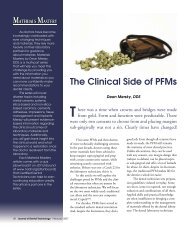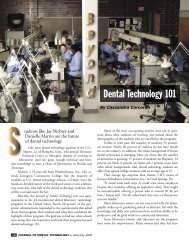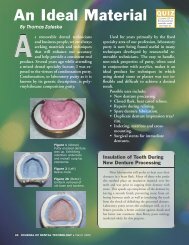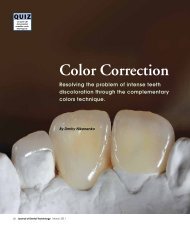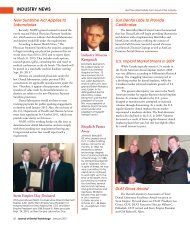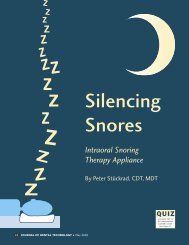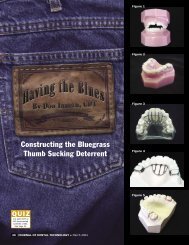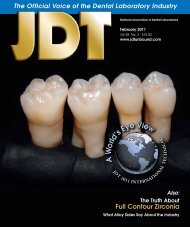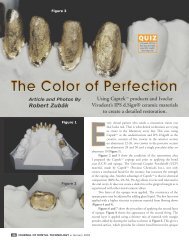The Importance of Lingualized Occlusion - JDT Unbound
The Importance of Lingualized Occlusion - JDT Unbound
The Importance of Lingualized Occlusion - JDT Unbound
- No tags were found...
You also want an ePaper? Increase the reach of your titles
YUMPU automatically turns print PDFs into web optimized ePapers that Google loves.
authors S.J. Davies, R.J.M. Gray and M.P.J. Young<br />
write <strong>of</strong> lingualized occlusion:<br />
“<strong>The</strong> key feature is the arrangement <strong>of</strong> the<br />
posterior teeth so that only the maxillary palatal<br />
cusps (hence: ‘lingualized’ occlusion; or should it<br />
have been called ‘palatalised’ occlusion) occlude<br />
with shallow mandibular central fossae. <strong>The</strong>re is<br />
no contact between the mandibular buccal cusp<br />
and palatal maxillary cusps which might result<br />
in a inclined (non-axial) contact. Laboratory<br />
fabrication time is reduced and this scheme<br />
represents a posterior occlusion that can be more<br />
readily observed in both the laboratory and clinical<br />
environments thereby enabling any unfavorable<br />
occlusal contacts to be identified and corrected<br />
more easily.”<br />
This type <strong>of</strong> occlusal philosophy has been<br />
advocated for quite some time. Many <strong>of</strong> the great<br />
dental giants (Gerber, Pound, Frush, Trubyfield,<br />
Massad and others) have advocated this type <strong>of</strong><br />
denture occlusion. It is interesting when you<br />
study the writings <strong>of</strong> these dentists that the<br />
arrangement <strong>of</strong> the occlusion is only a part <strong>of</strong> the<br />
whole treatment, most <strong>of</strong> the steps leading to the<br />
posterior set are concerned with proper occlusal<br />
registration and positioning <strong>of</strong> the anterior teeth,<br />
lip support, incisal edge position, phonics and arc<br />
<strong>of</strong> closure. All <strong>of</strong> these things must be addressed<br />
well before we can determine how and where the<br />
posterior teeth are set. Despite all the time we,<br />
as technicians, spend setting articulation, setting<br />
teeth, waxing the gingival contours, processing and<br />
polishing, it is all in vain without the foundation<br />
<strong>of</strong> proper occlusal records and precise models. In<br />
most cases without proper occlusal records and<br />
precise models, the restoration will be ground<br />
endlessly by the dentist or not worn by the patient.<br />
This article will mainly focus on a simple<br />
lingualized set up and will touch on the anterior<br />
function leading up to it. This certainly is not an<br />
exhaustive study but simply the basics.<br />
OK let’s begin.<br />
At all possible costs, try and use a semiadjustable<br />
articulator and hopefully with a face<br />
bow, these are inexpensive today. <strong>The</strong> Whip Mix<br />
Ulti-Mate (Figure 1) is a good example <strong>of</strong> this<br />
type <strong>of</strong> articulator. Even without the face bow, if<br />
properly mounted, this type <strong>of</strong> articulator will be<br />
much better than the old hinge type as you can<br />
Figure 2<br />
Figure 1<br />
Figure 3<br />
Figure 4<br />
November/December 2009 Journal <strong>of</strong> Dental Technology 21





